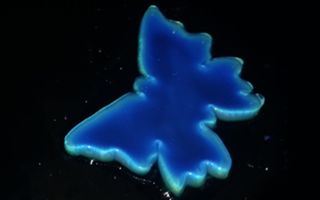Artificial Chameleon Skin Is Weird and Cool

A team of chemists has created a substance that can change its color and stiffness, which they're comparing to chameleon skin.
The stretchy material is made up of strands of copolymers — complex, self-assembling large molecules that in this case are shaped like long dumbbells, with spherical bulges on each end. The way those copolymers react to mechanical stress allows them to vary their stiffness and color, the researchers wrote in a paper published Friday (March 30) in the journal Science.
Like a chameleon, the substance doesn't undergo any chemical changes when it changes color. Instead, those tiny bulges at the ends of the copolymers move closer together or farther apart, changing how they interact with light. [6 Strange Species Discovered in Museums]
When the long copolymers weave together in cross-linked structures, the researchers wrote, they can "display vibrant color, extreme softness, and intense strain stiffening on par with that of skin tissue.
And, significantly, those copolymers are the only ingredients necessary to manufacture the substance. No other chemicals necessary.
In a statement, the researchers said that "active camouflage" is the ultimate goal of the project. In other words, this is part of an effort to design a material that could allow wearers to blend into the environment, chameleon style.
They also note in the paper that it doesn't dry out in air or swell when dipped in "bodily fluids" which is…uh…gross but also cool, Live Science supposes.
Sign up for the Live Science daily newsletter now
Get the world’s most fascinating discoveries delivered straight to your inbox.
Originally published on Live Science.

